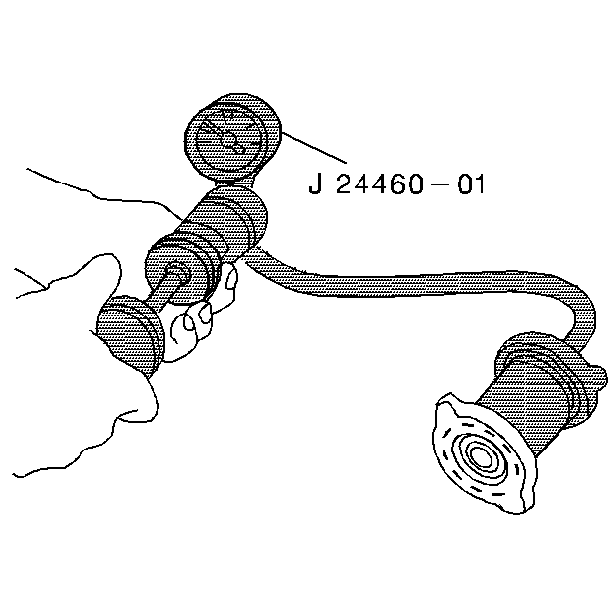Cooling System Leak Testing Radiator Leak Test
Tools Required
J 24460-01 Cooling System and Cap Pressure Tester
Leak Testing Procedure (On Vehicle)
- After the system has cooled, remove the radiator/surge tank pressure cap.
- Connect the cooling system tester J 24460-01 to the radiator/surge tank.
- Apply normal system operating pressure. Do not exceed 138 kPa (20 psi).
- Watch the gauge needle for an indication of a leak. Examine all cooling system connections and components, including the radiator and the heater core, for leaking coolant.
- Tighten the hose connections or repair as required.
- Check the radiator/surge tank cap with J 24460-01 in order to ensure the cap maintains the correct pressure.
- If the radiator leaks during the pressure test, mark the leak area so the leak can be located once the radiator has been removed from the vehicle.
Caution: Under pressure, the temperature of the solution in the radiator can be considerably higher, without boiling. Removing the radiator cap while the engine is hot (pressure is high), will cause the solution to boil instantaneously, with explosive force. The solution will spew out over the engine, fenders, and the person removing the cap. Serious bodily injury may result. Flammable antifreeze, such as alcohol, is not recommended for use at any time. Flammable antifreeze could cause a serious fire.
Caution: In order to help avoid being burned, do not remove the radiator cap while the engine and the radiator are hot. Scalding fluid and steam can be blown out under pressure if the cap is removed too soon.



Testing Procedure (Off Vehicle)
- Plug the inlet and outlet tubes. Make sure the drain cock is closed.
- Attach the J 24460-01 to the radiator.
- Apply pressure to the radiator. Do not exceed 138 kPa (20 psi) of pressure.
- Observe the gauge for any pressure loss.
- Run water over the repair area and look for any bubbles. If a large tank is available, the radiator can be submerged in order to check for air bubbles.
Notice: Do not use boil-out tanks or any other tank that has been used for copper or brass radiators. The remaining solutions or chemicals in these tanks could cause radiator failure.
Cooling System Leak Testing Radiator Cap Leak Test
Radiator Cap Pressure Test
Tools Required
J 24460-01 Cooling System and Cap Pressure Tester
- Remove the radiator cap.
- Wet the radiator cap gasket with water. Wash off any sediment from the sealing surface.
- Install the cap to J 24460-01 .
- Pump up the pressure to 103 kPa (15 psi) by operating the plunger handle of J 24460-01 .
- Note the rate of decrease in pressure.
- The pressure reading should remain within the corresponding pressure segment of the scale for about 10 seconds.
- If the cap does not hold the corresponding pressure, replace the cap.
Caution: As long as there is pressure in the cooling system, the temperature can be considerably higher than the boiling temperature of the solution in the radiator without causing the solution to boil. Removal of the pressure cap while the engine is hot and pressure is high will cause the solution to boil instantaneously -- possibly with explosive force -- spewing the solution over the engine, fenders and the person removing the cap.

